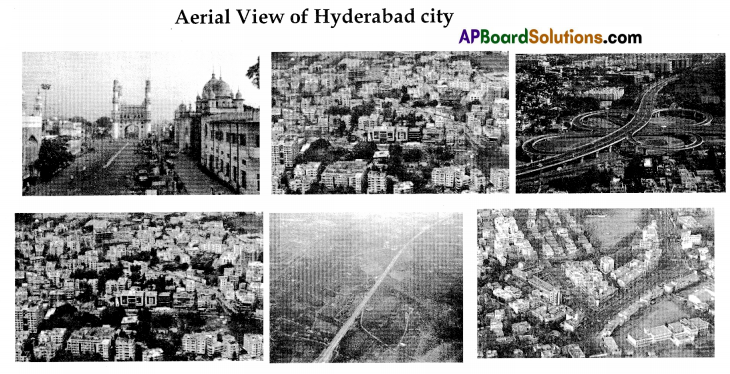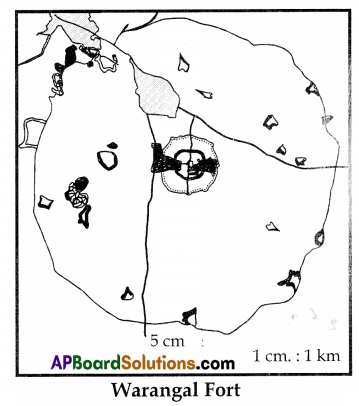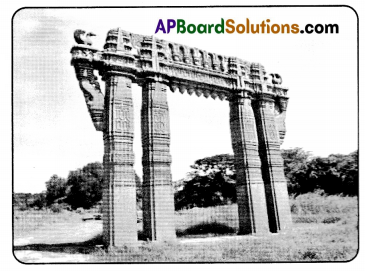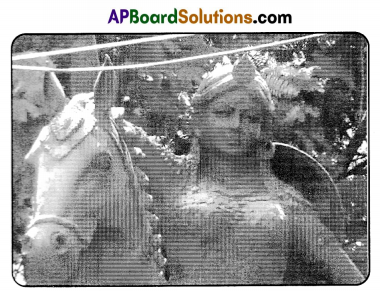Telangana SCERT TS 7th Class Social Study Material Pdf 12th Lesson The Kakatiyas: Emergence of a Regional Kingdom Textbook Questions and Answers.
TS 7th Class Social 12th Lesson Questions and Answers – The Kakatiyas: Emergence of a Regional Kingdom
Improve Your Learning
Question 1.
Compare the warriors of those times with what you know about the armies of modern times. What differences do you see between them?
Answer:
In ancient times, the sarriors sought to establish small kingdoms and these ambitious warriors fought against each other constantly. Many of the leaders of these communities were also great warriors who led their mobile people not only in grazing hut also in battles, Butin modern times these armies are meant to give protection to the people of the country and to protect the country from foreign invasions. The modern armies are using advanced techniques in war field compared to warriors of olden days.
Question 2.
Kings and chiefs built irrigation tanks to improve agriculture in the Kakatiya times. What would they do if they ruled now?
Answer:
The kings and chiefs built irrigation tanks like Pakala. Cheruvulu. Ramappa. Warangal – Bhadrakali cheruvu. They are useful even today – hats off to the long sight of the kings.
Question 3.
How do you think were the Kakatiyas able to gain control over the chiefs?
Answer:
- In ancient period there were many chiefs and clans all over the Andhra Pradesh region who independently controlled a small area. They were constantly at war with neighbouring chiefs and warriors who tried to conquer them.
- As Kakatiya kings became powerful, they were able to persuade many chiefs to accept them as their kings
- Once the chiefs accepted the Kakativa king, the king gave protection to the chiefs from other warriors and chiefs.
Question 4.
Why do you think did the Kakatiyas not appoint powerful chiefs as Nayakas?
Answer:
The Kakativas did not appoint powerful chiefs as Nayakas because
- They may destabilize the kingdom and may not be loyal to Kakatiyas.
- Often the chiefs were rebellions.
- Hence Kakativas encouraged several warriors who were not from powerful families.
- The Kakatiyas thought that the warriors would be loyal to them when compared with chiefs.
Question 5.
Why was it difficult for women to rule in those days? Is it different today? How?
Answer:
A few women like Rudramadevi and Razia Sultana ruled some of the kingdoms at that time. It is different today because women too are ruling countries. There is no discrimination towards women nowadays. All are equal before law. Those men were prejudiced and reluctant to be under the rule of women.
![]()
Question 6.
In those days powerful men had their own land and were also able to tax other farmers, traders, and artisans. Can powerful people do this now? Give reasons.
Answer:
No, the powerful people can’t do this now because the administration of kings, chiefs, nayakas, and powerful men had gone. The parliamentary form of democratic government system is introduced in India. As per this system, all are equal before law and all of them have to pay their taxes to government only.
Reading the text (given), understanding and interpretation
Question 7.
Rudramadevi and Pratuparudra encouraged several skilled warriors who were not from any powerful family but were very loyal to the queen and the king. They gave them high positions and the title of Nayaka. They were given several villages from where they could collect taxes. These villages were called their Naankara. Each nayaka had to maintain a stipulated amount of army from the income, they get from the nayankara for the service of the king.
But they did not keep these vIllages permanently as they could be transferred at the will of the king to a new place. These Navakas depended upon the queen or the king and remained loyal to them. They were also probably used to subdue the rebellious chiefs. This arrangement was called Nayankara system.
Read the above para under the title ‘Nayankara system’ of page 111 and comment on it.
Answer:
- The Kakatiyas introduced decentralization of administration through “Nayankara system”!
- It resembles Mansabdari system of Mughals.
- Some warriors of powerful families were given some villages to collect taxes.
- Each Nayaka had to maintain a stipulated amount of army.
- They could be transferred at the will of the king.
Question 8.
Women too manage the administrative affairs effectively- Do you support this statement?
Answer:
- Yes, women can manage the administrative affairs effectively.
- Rani Rudramadevi was a powerful and successful ruler.
- She impressed every one with all her abilities.
- In Delhi, too, there was a women ruler called, Raziya Sultana, She was killed by her nobles.
- Marco Polo, an Italian traveller visited Rudramadevi’s kingdom.
- He appreciated Rudramadevi saying she was fearless, dressed herself like a man and rode horses with ease.
- Rudramadevi faced many oppositions but she succeeded in subduing them.
- Even in present times, Smi Sonia Gandhi, Mamata Banerjee, Jayalalithaa proved that they can effectively manage administrative affairs. In the administration of corporate companies, Chanda Kocher of ICICI bank, Kiran Mazumdar Shah of Biocon proved their worth.
- From the above points it is clear that” women too manage the administrative affairs effectively.
Project Work
Question 1.
Prepare a short presentation of any of the three stories In the form of a play.
Answer:
Coronation of Rudramadevi
Ganapathideva of Kakatiya Empire had no male children. He wanted to coronate Rudramadevi as his successor. He sent for Rudramadevi.
Ganapatideva : My beloved daughter Rudrama ! Age is falling on me. Unless there is a strong ruler, the law and order does not run smoothly. The enemies take the opportunity. I request you to he the next ruler for this mighty Kakatiya Kingdom. Minister Sivadeva assists you.
Rudrama: Oh! Dad! Dont, worry! I am here to serve the people and the kingdom. I accept the responsibility graciously. (Meanwhile, Sivadevaiah came.)
Sivadevaiah: My services to thee my Lord!
Ganapatideva : Sivadevaiah! I want to make Rudramadevi next ruler, But I fear whether our enemies and people tolerate a lady ruler.
Sivadevaiah: Who said a lady has no right to throne. No Dharma has objected it. Rudrarnadevi has the guts to control and check enemies.
She is an able lady.
Ganapatideva : Thank you Sivadevaiah ! Make arrangements for crowning
Rudramadevi. Ask the priests to set an auspicious time for the coronation
Rudrarnadevi! Keep the glory of Telugu on top. Let your rule establish a golden era in Telugu History. May God bless you!
![]()
Question 2.
Collect some popular stories that originate from your village or town and prepare a chart and present the same in the class.
Answer:
Our city is Warangal.
- The city was once called Yekasila Nagaram
- Yekasila means single stone. The Siva l.inga in Varangal is constructed with single stone. So, this was called Yekasila Nagaram. It is Oru Kallu. Oru means single. Kallu means stone. It is later changed to Warangal.
- Another story is that it was named after Subrahmanyeswara. the deity of valour and second son of Lord Shiva. His beauty was compared to that of Sakhi Visakha.
Question 3.
Visit an old tenle of your area and find out who built the temple, when etc., and look for any inscriptions in it.
Answer:
I visited Palampet near Warangal. Here there is famous Ramappa temple built in 12th century by Recharla Rudrudu. The temple is famous for its architectural and structural values. On the walls of the temple we find postures of classical dance taken from the book ‘Nrutya Ratnavali’ by Jayapa Senani. On the roof of the temple inscriptions from Ramayana and Mahabharatha are written. The bricks used for the construction of this temple floats on water.
Intext Questions
Text Book Page No. 110
Question 1.
Find out from your parents and elders the stories of the Palnati Virulu, Sammakka – Sarakka, and Katama Raju. ReLate these stories in the class. (Appreciation and Sensitivity)
Answer:
Stories of the Palnati Virulu: Palnadu is in the northern region of Guntur district in the state of Andhra Pradesh. It is also known as Pallava Nadu. It occupies an important place in Telugu history. After the decline of the Satavahana dynasty, the Pallavas became independent in Krishna river valley 11w region is known as Palnadu in memory of ancient Pallavas. The battle of Palnadu was immortalized in Telugu literature by the poet Srinatha in his Palnati Vira Charitha.
a) Story of Palnati Brahma Naidu:
PALNATI’ RFCHERLA BRAHMA NAYUDU, a valiant fighter, both his father Dodda Nayudu and later he himself were appointed and served as ministers for the then ruling Alugu Raju in Palnadu area from Macherla.
Brahmana, as he is popularly called was a staunch Vaishnavite and a devotee of Chenna Kesava. He was responsible for construction of Chenna Keshava Swami temple in Macherla town which is popular even today.
Brabmanna is said to have adopted a son, a brave warrior called Kannamma, a mala by caste, as he was childless for a long time. The deceitful infamous Nayakuralu Nagamma a widow, was the minister for the rulers (Nalagama Raju and Narsinga Raju, etc.,) of Gurajala a small town in Palnadu region.
Brahmanna along with his troops lived in exile as per agreement for six and half years after loosing Macherla to Nagamma in a cock fight. After the exile, there was a severe battle between Brahmanaidu forces and Nagamma forces and there was a severe loss of lives. The battle of Palnadu is remembered and propagated through Burra Katha even today by the people of Palnadu region, and through an annual gathering at the battlefield in Karampudi village to pay respect to warriors.
b) Sammakka – Sarakka (or) Saralamma:
Sammakka Saralamma Jatara (or) Medaram Jatara is a tribal festival of honouring the goddess celebrated in the Telangana state of India. The Jatara begins at Medaram in Tadvai Mandai in Warangal District. It commemorates the fight of a mother and daughter, Sammakka and Saralamma, with the reigning rulers against an unjust law. It is believed that after Kumbha Mela, the Medaram Jatara attracts the largest number of devotees in the country.
It is celebrated in Medaram during the time the goddess of the tribal is believed to visit them. Medararn is a remote place in the Eturunagaram wildlife sanctuary, a part of Dandakaranya, the largest surviving forest belt in the Deccan. Sammakka Sarakka Jatara is the time for the largest tribal religious congregation in the world, held every two years.
C) Katama Raju: Katamaraju, the king of Kanigiri, a Yadava King who fought a battle with Nalla Siddi the king of Nellore, on the banks of the Paleru river in the thirteenth century. Katamaraju due to severe drought conditions had migrated with his people to the fertile lands of Nellore, There he entered a covenant with the king of Neliore for grazing his cattle and sheep. Due to misunderstanding, the covenant was broken and resulted in a tremendous battle in which many of the great heroes of both sides lost their lives.
All the above stories describe the battles of the warriors to enable their herder- followers to settle down as agriculturalists.
Text Book Page No. 111
Question 2.
This was also the time when the first books in Telugu were written. According to tradition, Srimad-Andhra Mahabharatam is the first poetic work in Telugu which was composed by Kavitraiiamu, the Trinity of Poets – Nan na ya, Tikkana, and Erra Pragada between 1000 and 1200 AD.
We have a large number of inscriptions which tell us about the activities of the kings, queens, chiefs, farmers. herders and traders. We also have a number books written about them in Sanskrit and Telugu. Viduantha wrote Prathaparudra Y&w&hushwiarn during the Kakatiya rule. Some works were also written after the end of their rule (Vinukonda Vallabharavas Kridabhiramarnu, Ekamranatha’s Prataparudra Owritratnu) Having read the above passage, can you identify the two important sources of information about the Kakatiya kings? (Reading the text (given) understanding and interpretation)
Answer:
There are two sources are there one is literature and another one is inscription.
Literature:
- Prathaparudra Yashobhushanam written by Vidyanadha during Kakatiya rule.
- Vinukonda Vallabharaya’s Kridabhiramam.
- Ekamranatha’s Prataparudra Charitraniu.
inscription : Bayvaram, Thousand piliers temple, Nagulapadu, Pillalarusri. Palampet, Kondaparthi and Bhithpur.
![]()
Text Book Page No. 112
Question 3.
Can you draw a rough map of your village or town and compare it with the map Orugallu? (Mapping skills & Appreciation and Sensitivity)

Answer:
We can observe number of agricultural lands, several water tanks, huts of many artisans like basket weavers, forts made of mud and forts made of stone in Orugallu map. ut in our city map we find number of houses constructed by concrete. iron and cement. Trees are not there.

Question 4.
What are the main differences between modem towns and (ities of the past like Orugallu?
Answer:
In ancient period there were agricultural lands, several water tanks, huts of many artisans like basket weavers who were considered untouchable and were not allowed to settle within the city. We can find a moat, a fort waLl nude of mud and another moat and fort wall made of stone. In the centre of the city, there is a temple of Svayanihhu Shiva.
For example, now towns and cities are developing using modem technology. Warangal is the headquarters of Warangal district. Nowadays agricultural lands and several water tanks are decreasing. We can’t see untouchability nowadays when compared with ancient period. Kakatiya University, Regional Engineering College, and Medical College are the important institutions in Warangal now.
Question 5.
Use the scale shown on the map to find out the breadth of the outer wall from East to West.
Answer:
The breadth of the outer wall from east to south is nearly 9 kilometers 1 cm =1 km. The fort is in circular shape. I-fence diameter is to be considered but not breadth. It is 9 cms from east to west. 111 cm is taken as I kin, 9 cms equal to 9 km.
Question 6.
Also, find out the breadth of the city within the inner stone wall from North to South.
Answer:
The breadth of the city within the inner stone wall from North to South is approximately \(\frac{1}{2} \) km.
Question 7.
If you have ever been to Warangal City, describe it to your classmates. (Appreciation and Sensitivity)
Answer:
Warangal, was called as Orugallu region. This place was under the rule of Satavahana, Yadava, Chalukya and Kakatiya kings. flic period of Kakatiya rule is termed as Golden Era. The fort of Orugallu was constructed in the 13th century by a Kakatiya ruler by name Rudramadevi.
Historical structures like a temple with one thousand pillars, Nandi carved out of black stone etc., are located which attract many tourists. The Ramappa temple constructed in 1264 in Palampet near Warangal is a very famous temple. Warangal is known for its granite quarries, also known as a market for rice. pepper cotton and tobacco. This town is also known as Tn-city with Warangal, Hanamkonda, and Kazipet in them. Kakatiya University, Regional Engineering College, and Medical College are located in Warangal.
Question 8.
Svayambhu Shiva was the family god of the Kakatiyas. Why do you think they built the temple and not a palace or a market place in the middle of the city?
Answer:
Kakatiyas were ardent devotees of Siva. They built temple in the middle of the city because
- They wanted to show their devotion towards God Siva.
- They could know the opinions of public directly when the public visited temple which was in the middle of the city.
- In olden days. all the cultural and trading activities were related with the temples. They believed that the city could flourish well if the temple was in the middle of the city.
- The different occupational people living in different wadas’ could go to temple in stipulated roadways as the temple was in the middle of the city and had four entrances.
Text Book Page No. 114
Question 9.
Why do you think Bollinayaka was calling Rudramadevi as Rudradeva Maharaja? (Appreciation and Sensitivity)
Answer:
Rudramadevi was a brave woman ruler. She was a powerful and successful ruler who impressed one and all with her abilities. A famous traveler from Italy called Marco Polo visited Rudrarnadevis kingdom and he described that she was fearless. dressed herself like a man and rode horses with ease.
In fact in her inscriptions, Rudramadevi called herself Rudradeva Maharaja. Bolli Nayaka the guardian of the gate for Kakativa Rudradeva Maharaja, gave 10 measures of land to the temple servants of God Kalyana Keshava of Kranja Village for the merit of his master Rudradeva Maharaja in the year (1270 A.D.) on the occasion of Sankranti. Because of her abilities, Bollinayaka called Rudrarnadevi as Rudradeva Maharaja.
![]()
Text Book Page No. 115
Question 10.
Read a portion of an inscription issued by Kakatiya king Ganapatideva in a place called Motupalli.
“This Ahhava Siwsana has been granted by Ganapatideva fo sea traders going back and forth to all continents, countries and towns. In the past, kings forcibly seized all the cargo such as gold. elephants, horses, jewels, etc. when sea-going vessels were caught in storms. weekend and cast on shore, But we for the sake of our reputation and pun ya and out of pity for those who have incurred the grave risk of a sea voyage, give up ail but the customary tax”. (Reading the text (given), understanding and interpretation)
a. How did the kings treat the traders earlier?
Answer:
Earlier, the kings used to seize all the cargo of sea traders.
b. What was the guarantee Ganapatideva was giving to them?
Answer:
The guarantee was that the Icing would give back all the wealth brought by sea traders to them levying customary tax only on the goods. The king would not seize the cargo like the earlier kings did.
c. Why do you think Ganapathideva was giving this protection to the traders?
Answer:
This protection would attract sea traders to the ports maintained by Kakatiya kings because the king gave a guarantee that their wealth would not be seized but only taxes would be levied. This enabled the kings to get good revenue on the trade.
Additional Questions
Two Marks Questions
Question 1.
What is the first poetic work in Telugu?
Answer:
“Srimad-Andhra Mahabharatam” is the first poetic work in Telugu.
Question 2.
Who wrote Srimad-Mahabharatam in Telugu?
Answer:
It was written by i(avitrayarnu’, the trinity of poets – Nannaya. Tikkana and Erra Pragada.
Question 3.
Name the hook written by Vidyanttia.
Answer:
The book written by Vidyantha was “Prathaparudra Yashobhushanam”.
Question 4.
What was the court language of Kakatiyas?
Answer:
Telugu was the court language of Kakatiyas.
Question 5.
When did the Kakatiyas become independent rulers?
Answer:
Kakatlyas became independent rulers after the fall of Western Chalukyas.
Question 6.
What was the capital of Kakatiya during Rudradeva Period?
Answer:
Orugallu (Warangal) was the capital of Kakatiyas during Rudradeva’s period.
Question 7.
What were the works of Rudradeva?
Answer:
Rudradeva built a big fort, a tank, and a temple called Thousand Pillared Temple in Anumakonda.
Question 8.
Who was the women ruler of Delhi?
Answer:
Raziya Sultana.
![]()
Question 9.
Who was the women ruler of Orugallu?
Answer:
Rudramadevi was the women ruler of Orugallu.
Question 10.
Who was the foreigner that visited Rudramadevi’s Kingdom?
Answer:
A famous traveller from Italy. called “Marco Polos visited Rudramadevi’s kingdom.
Question 11.
What was the port city of Kakatiyas?
Answer:
“Motupall? was the port city of Kakatiyas.
Question 12.
Who was the last ruler of Kakatiyas?
Answer:
Prataparudra was the last ruler of Kakatiyas.
Question 13.
Who defeated Prataparudra?
Answer:
Sultan Mohammad-bin-Tuglaq defeated Prataparudra.
Question 14.
What were the two kingdoms that established in South India after the downfall of Kakatiyas?
Answer:
Tiahamani and Vijayanagara kingdoms.
Reading the text (given), understanding and interpretation)
Read the passage and answer the following question.
Rudramadevi and Prataparudra en c-ou raged several skilled warriors who were not from any powerful family but were very loyal to the queen and the king. They gave them high positions and the title of Nayaka. They were given several villages from where they could collect taxes. These villages were called their Nayankara. Each nayaka had to snain tain a stipulated amount of army, from the income they derived from the nayankara. for the service of the king.
But they did not keep these villages permanently as they could be transferred at the will of the king to a new place. These Nayakas depended upon the queen or the king and remained loyal to them. They were also probably used to subdue the rebellious chiefs. This arrangement was called Nayankara system.
Question.
Write about Nayankara System.
Answer:
- Rudramadevi and Prataparudra encouraged several skilled warriors.
- They gave them high positions and the title of Nayaka.
- They were given several villages from where they could collect taxes,
- These villages were called their ‘Nayankara.
- They were loyal to the king and the queen.
- These Nayakas” were also used to subdue the rebellious chiefs.
- This arrangement was called ‘Nayakara Systems.
Information Skills
A. Read the passage and answer the following questions.
The Kakativas also extensively patronized temples by making large donations to them. Women members of the royal family like Muppamamba, and Mailamma made land grants. Women of other rich sections also made gifts of land, and tanks. cash, cattle, jewelry, etc., to temples and brahmins. By promoting agriculture they derived income in the form of taxes and agricultural produce.
1. How did Kalcatiyas patronize temples?
Answer:
The Kakativas extensively patronized temples by making large donations to them.
2. Name the members who were women that gave grants.
Answer:
Mappamamba and Mailamma.
3. What were the gifts given to temples and Brahmins?
Answer:
Gifts of land, tanks, cash, cattle, jewelry, etc., were some gifts given to temples and Brahmins.
4. How did the Kakatiyas derive income?
Answer:
By promoting agriculture Kakatlyas derive income.
5. What were different forms of income?
Answer:
Taxes and agriculture produce.
![]()
B. Read the passage and answer the following questions:
Sometime around 1190 AD a new kingdom was established in Delhi. The new kings were called Sultans and they originally came from Turkistan. They had a powerful army and were able to defeat most of the kings of North India and the Deccan before long. Sultan Mohammad bin Tugluq was able to defeat Kakatiya Prataparudra in 1323 AD. This ended the Kakatiya dynasty.
1. Who was the new kings of Delhi?
Answer:
Sultans.
2. From where did the Sultans come?
Answer:
From Turkistan.
3. How could the Sultans defeat the kings of North India?
Answer:
They had powerful army and were able to defeat most of the kings of North India.
4. Who defeated Prataparudra?
Answer:
Ms. Sultan Muhammad-hin-Tugluq.
5. When did the Kakatiya kingdom ended?
Answer:
In 1323 AD.
C. Read the passage and answer the following questions:
The early members of the dynasty began their careers as warriors and Sarnanthas of Rashtrakuta and Chalukva kings who were ruling in Karnataka. They were holding the posts of village heads called Rattadi and through their military skills became army chiefs, Sarrranthas, etc., and gained control over Anumakonda in Telangana. The Kakativas emerged as independent rulers after the fall of Western Chalukyas.
1. Who were the early members of Kakatiya dynasty?
Answer:
The early members were warriors and Samanthas of Rashtrakuta and Chalukya kings.
2. What was the name given to the village heads?
Answer:
Rattadi.
3. What was the area that came under the control of Kakatiyas first?
Answer:
Anmakonda in Telangana.
4. Who were the kings of Karnataka?
Answer:
Rashtrakutas and Chalukyas.
5. When did the Kakatiyas actually gained control?
Answer:
After the fall of Western Chalukyas.
D. Read the passage and answer the following questions:
During Rudradeva’s rule (1158-1195 AD) the capital was shifted from Anumakonda to Orugallu (Warangal), The new city was laid out with a plan to accommodate increase in city population and to address the needs of an imperial capital. Rudradeva built a big fort, a tank and a temple called Thousand Pillared Temple in Anumakonda.
1. What was the period of Rudradeva?
Answer:
1158-1195 AD.
2. Who shifted capital from Anumakonda to Orugallu.
Answer:
Rudradeva shifted capital from Anumakonda to Orugallu.
3. Who was Rudradeva?
Answer:
He was a ruler of Kakativa dynasty.
4. Why did he (Rudradeva) built the new capital f
Answer:
To accommodate increasing city population and to address the needs of an imperial capital.
5. What did Rudradeva build f
Answer:
He built a big fort, a tank, and a temple called Thousand Pillared Temple in Anumakonda.
E. Read the following and answer the questions:
IMPORTANT KAKATIYA RULERS
Prolall – 1116-1157AD
Rudradeva – 1158-1195 AD
GanapatiDeva – 1199-1262 AD
Rudramadevi – 1262- 1289 AD
Prataparudra – 1289 – 1323 AD
1. Who ruled for a long period?
Answer:
Gariapati Deva
2. Who was the last ruler of Kakatiya Kingdom?
Answer:
Prataparudra
3. What was the total period of Kakatiyas?
Answer:
From 1116 All – 1323 All 207 years.
4. Who was the women ruler of Kakatlyas?
Answer:
Rudramadevi
![]()
5. What was the period of Rudradeva?
Answer:
1158-1195 AD.
6. How many years did Rudramadei rule?
Answer:
27 years.
(Appreciation and Sensitivity)
Question 1.
Write the greatness of the Kakatiyas as Telugu rulers.
Answer:
- Kakativas ruled from 1116 AD to 1323 A.D.
- They adopted Telugu as the favoured language of the court.
- They called themselves as Andhra Rajas.
- They brought together all the three Telugu regions in which Telugu is spoken.
- They constructed man temple. cities showing Telugu tradition and culture.
- Trade with foreign countries flourished well.
Question 2.
What does the below pictures represent?
Answer:
a)

Answer:
Kirti Torana entranceofSvavamhhu Siva Temple – built by Kakati a kings in Warangal.
b)

Answer:
Rudramadevi – Riding the horse. (Modern representation in Hyderabad).
c)

Answer:
Gold coin issued by Kakatiyas.
Work Books
Question 1.
As per the ruling order, what was the corred order ……………… . ( )
A) Rurdramadevi, Prataparudra, Ganapati Deva
B) Ganapati Deva, Rudramadevi, Prataparudra
C) Prataparudra, Rudramadevi, Ganapati Deva
D) None
Answer:
B) Ganapati Deva, Rudramadevi, Prataparudra
Question 2.
Rudramadevi ruled Kakatiya Kingdom for nearly ………………… years. ( )
A) 25
B) 26
C) 27
D) 30
Answer:
C) 27
Question 3.
Raziya Sultana was a woman ruler of …………………… . ( )
A) Orugallu
B) Yadagiri gotta
C) Delhi
D) Hyderabad
Answer:
C) Delhi
Question 4.
Hanumakonda is in …………………… region. ( )
A) Coastal Andhra
B) Telangana
C) Rayalaseema
D) None
Answer:
B) Telangana
![]()
Question 5.
In whose rule the capital of Kakatiyas shifted from Anumakonda to Onigallu ………….. . ( )
A) Rudramadevi
B) Rudradeva
C) Prataparudra
D) None
Answer:
A) Rudramadevi
Question 6.
Palanati Virula katha was written by Srinatha in …………………….. . ( )
A) 1250
B) 1350
C) 1450
D) 1750
Answer:
C) 1450
Question 7.
Ramappa temple is in …………………….. . ( )
A) Khammam
B) Warangal
C) Hyderabad
D) Vinukonda
Answer:
B) Warangal
Question 8.
Rudramadevi was daughter of ……………………. . ( )
A) Prataparudra
B) Ganapathideva
C) Prola-I
D) None
Answer:
B) Ganapathideva
Question 9.
Goddess of Kakatiyas …………………… . ( )
A) Saraswathi
B) Durga
C) Kakathi
D) None
Answer:
C) Kakathi
Question 10.
Thousand Pillars Temple was built by …………………. . ( )
A) Kakatiyas
B) Delhi Sultans
C) Chalukyas
D) Pallava
Answer:
A) Kakatiyas
Question 11.
These are called Kavitrayamu ……………….. . ( )
A) Pothana, Nannaya, Singana
B) Nannaya, Tikkana, Yerrapragada
C) Srinadha, Dtiijati, Teriali Ramakrishna
D) Peddana, Mallana, Tikkana
Answer:
B) Nannaya, Tikkana, Yerrapragada
![]()
Question 12.
The Kakatlyas traced their lineage to ( )
A) Durjaya
B) Swayambhu
C) Kakati
D) Vallabha
Answer:
A) Durjaya
Question 13.
Prior to becoming Samanthas, Kakatiyas were ………………. . ( )
A) Rattadi
B) Sepoys
C) Horse riders
D) Dancers
Answer:
A) Rattadi
Question 14.
Rattadi means …………………… . ()
A) Soldier
B) Village head
C) Poet
D) Samantha
Answer:
B) Village head
Question 15.
The original name of Warangal ………………… .
A) Anmalconda
B) Oravakallu
C) Orugallu
D) Orangal
Answer:
C) Orugallu
Question 16.
Nayakas of Kakatiya rule were given villages to collect taxes army. These villages are called ………………. . ( )
A) Vadas
B) Pallis
C) Nayankaras
D) Kallus
Answer:
C) Nayankaras
Question 17.
The Italian traveller that visited Kakatiya kingdom
A) Marco Polo
B) Vasco-da-Gama
C) Paez
D) Nikolokanti
Answer:
A) Marco Polo
Question 18.
Match the following
Part-A Part-B
1) Vinukonda Vallahharava ( ) a) Prataparudra Yashobhushanarn
2) Ekamranath ( ) b) Kridahhiramam
3) Vidvanadha ( ) c) Prataparudra Charitram
A) 1-a, 2-b, 3-c
B) 1-b, 2-c, 3-a
C) 1-c, 2-b, 3-a
D) 1-b, 2-a, 3-c
Answer:
B) 1-b, 2-c, 3-a
Question 19.
First poetic work of Telugu
A) Ramavanarn
B) Srimad – Andhra Mahabharatam
C) Prataparudra Vashobhusha narn
D) Kridab Hiramamu
Answer:
B) Srimad – Andhra Mahabharatam
Question 20.
The coin belongs to

A) Kakatiyas
B) Vijavanagaras
C) Bahmanis
D) Pallavas
Answer:
A) Kakatiyas
Question 21.
An important appreciable feature of Kakatiyas to agriculture
A) they brought vast forest lands to agriculture
B) they built tanks
C) they encouraged tribes
D) they introduced new crops
Answer:
B) they built tanks
![]()
Question 22.
One appreciable feature of Rudramadevi
A) She was fearless and subdued enemies
B) She encouraged poets
C) She collected heavy taxes
D) She gave freedom to Navakas.
Answer:
A) She was fearless and subdued enemies